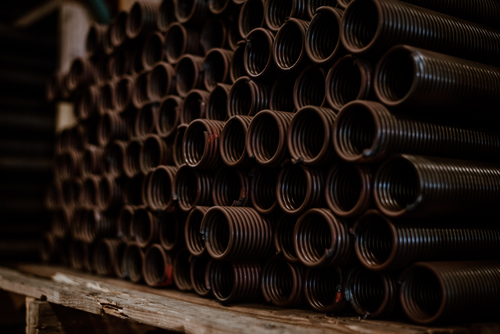One of the most common problems garage door repair experts come across is uneven door movement— the door isn’t opening fully, it is operating too slowly or moving too quickly. Nine times out of 10, these issues come down to the springs. Whether it is garage door extension springs or torsion springs wound around a pipe, these springs are essential for balancing the door’s weight and keeping it moving smoothly.
Without garage door springs, a typical garage door (usually between 50–100 pounds) could jerk as it moves or even come crashing down, which could be dangerous. Bottom line? Springs are critical for safe and reliable door operation.
With proper installation and maintenance, sectional garage door springs are engineered to last a minimum of 10,000 cycles. This could be around five to 10 years, depending on how frequently the door is used. But springs are delicate and can fail due to wear and tear. How do you avoid that? Here are some tips we recommend to maximize the life cycle of your customers’ garage door springs.
Match the garage door spring to the job
Make sure the torsion spring’s specifications (size, type) are properly matched to the door’s weight and requirements, such as the required number of turns applied to the spring. A mismatch can overstress the spring and reduce its cycle life. It is important to double check spring identification and parameters to adhere to the garage door manufacturer's installation instructions.
Protect garage door springs against rust
Even a little rust can weaken torsion springs and cause them to break early. Keep springs protected from corrosion during storage and installation, especially in high-risk environments like coastal areas or places with chemical exposure (think chlorine, salt, etc.).
Handle with care
Spring wire is delicate. Even minor damage to it can substantially shorten a spring’s lifespan so be careful not to scrape or nick it during installation.
Check the stretch when installing a garage door spring
It is crucial to get the garage door spring’s stretch right at installation. When using torsion springs, too much or too little stretch can lead to excessive coil rubbing, which can lead to early breakage.
Lubricate the spring yearly
A simple way to add years to a garage door spring’s life is through regular lubrication. Lubing springs annually or every 10,000 cycles for high-use doors can boost cycle life by up to 40 percent. Make sure to use a spring-specific lubricant, like Pro SL from OHDParts.com.
Keep an eye out for damage from others on the jobsite
In new commercial builds, activities such as welding, painting or other trades can accidentally damage torsion springs. Talk to the general contractor and the other subs onsite to protect both the doors and springs while performing work in the surrounding area.
 Next steps
Next steps
To maximize the lifecycle of your client’s garage door springs, using high-quality products installed correctly makes all the difference. Check out the range of garage door extension springs and torsion springs at OHDParts.com to find the right fit.
For tools that make it easy to specify the right spring, OHD Parts is here to help. Simply register on our website, log in and visit the Spring Resources page to access the Spring Calculator and Spring Conversion Program—tools designed to help you find the perfect match.